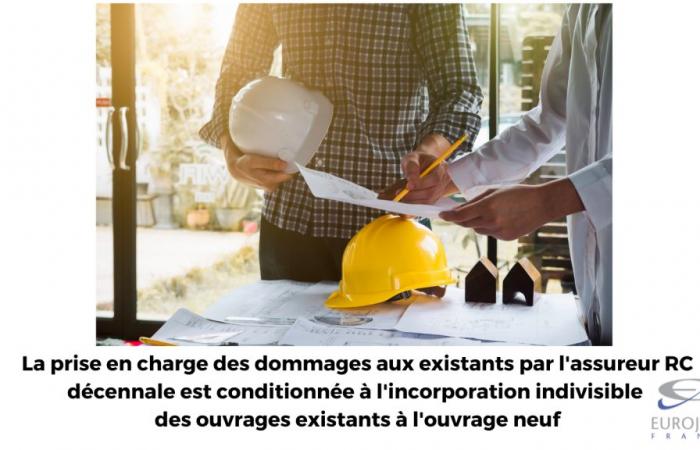
Des maîtres d’ouvrage ont confié à une entreprise des travaux de remplacement des tuiles de la couverture de leur maison d’habitation.
Complaining, after tacit acceptance of the worka deformation of the slope of the roof, the project owners had the roofing company and its insurer assigned to the date of the declaration of construction opening (AXA France Iard), as well as its insurer to the date of the claim (MMA Iard), for compensation for their various heads of damage.
By a judgment dated June 14, 2022, the Caen Court of Appeal ordered the roofing company to compensate the project owners and the company AXA France Iard to guarantee the sentences handed down, regarding damages caused to existing assets to be covered by the ten-year civil liability insurer.
In doing so, the Caen Court of Appeal considered that the company AXA France Iard, is aten-year liability insurerwas to guarantee the damage caused to the existing framework by the roofing work which consisted of the installation of tiles, since the roofing installed on the framework formed an indivisible whole to constitute a single roof.
The company AXA France Iard filed an appeal in cassation, maintaining that the insurance obligations laid down by articles l 241-1, l 241-2 and l 242-1 of the insurance code are not applicable to works existing before the opening of the site, unless they have become totally incorporated into the new work to become technically indivisible.
However, in this case, the appeal judges had not demonstrated how the existing work (the frame) had been completely incorporated into the new work (the roof) and had become technically indivisible.
The appeal judgment is overturned by the Court of Cassation by its judgment dated May 30, 2024 (Cass, 3rd civ, May 30, 2024, n°22-20.711, Published in the bulletin), the interest of which is sufficiently important to be published in the bulletin.
In support of its decision, the Court of Cassation recalls that compulsory insurance does not guarantee damage to the existing structure, caused by construction work of a new work, only in the case of technical indivisibility of the two works, the new and the old, and if the technical indivisibility proceeds from the total incorporation of the existing into the new.
So, according to this decision (and this is the whole point), the incorporation criterion must be assessed solely in consideration of the new work, in which the existing is incorporated to the point of becoming technically indivisible.
And to make itself clearly understood, proceeding in a redundant manner but with the merit of clarity, the Court of Cassation indicates that:
“ The two conditions are, therefore, cumulative and the damage suffered by the existing work is not guaranteed when it is the new work which is incorporated into it.. »
In this case, the subsidence claim was due only to the fact that the pre-existing framework was of insufficient strength to support the difference in load coming from the new tiles.
However, if it is not discussed that the company has indeed carried out a work and that the disorders affecting the roof are indeed likely to undermine its solidity and make the building unfit for its intended purpose within the meaning of article 1792 of the civil code, which only concerns the roofing company, the ten-year liability insurer is for its part justified in contesting the fact that the existing work (the framework) was found to be totally incorporated into the new work to become technically indivisible:
“By determining in this way, without characterizing how the existing work was totally incorporated into the new work, nor how they were technically indivisible, the Court of Appeal did not provide a legal basis for its decision. »
The company AXA France Iard having also been ordered to compensate the immaterial damages of the project owners under the optional guarantee of “ immaterial damage following guaranteed material damage », the cassation is also pronounced on this subject in complete consistency.
Therefore, it is indeed the “digestive faculty” of the new work which constitutes the only real criterion for triggering the compulsory ten-year liability insurance regarding damage caused to existing ones, since it is quite simply a question of ensure that the existing works have been completely absorbed by the new work carried out.
In the judgment of May 30, 2024, the Court of Cassation took care to specify that the roofing company had carried out work, in this case the replacement of the roof tiles.
This precision of language then necessarily leads to placing this judgment opposite the judgment rendered by the Court of Cassation on March 21, 2024 (Cass, 3rd civ, March 21, 2024, n°22-18.694, Published in the bulletin ), regarding separable pieces of equipment:
“If the elements of equipment installed as replacements or additions to an existing structure do not constitute a structure in themselves, they are neither covered by the ten-year guarantee nor the guarantee of proper functioning, whatever the degree of seriousness. of disorders, but of contractual liability under common law, not subject to compulsory insurance of builders. »
On this, when the element of equipment constitutes in itself a work, the applicable regime is that of article 1792 of the civil code, since the disorders affect the solidity or render the work unfit for its use. destination.
The ten-year liability insurer then only intervenes as a guarantee, for damages caused to the existing ones, if it is established that the existing works have been incorporated into the new works to the point of constituting an indivisible whole.
Failing this, any damage caused to existing equipment by the item of equipment falls under common law contractual liability, which may possibly be covered under the optional RC guarantee for damage to existing equipment or the TNCO guarantee (works not constituting a work), when it has been subscribed.
This article is solely the responsibility of its author.





